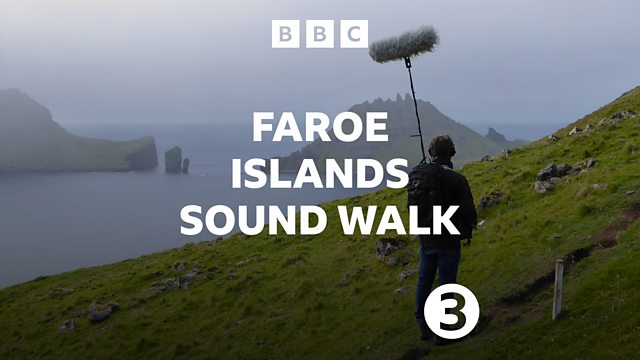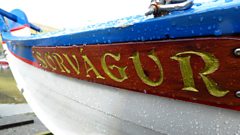
Vágar: The postman’s trail
Horatio Clare continues his Faroese journey on the western side of the archipelago, with a trip onto the water and a precipitous walk over a mountain.
Horatio Clare starts his second Faroese journey on the island of Vágar on the western side of the archipelago. From the small town of Sorvágur, he heads out onto the waters of the neighbouring fjord in the company of the local under-14s rowing team, currently the Faroese junior champions. Today, rowing is the islands’ national sport, but the traditional six- and eight-oar wooden boats have contributed to the livelihood of the Faroe Islanders for centuries, as a means of transportation out to the fishing grounds and between settlements.
On still waters under clear skies, they head down the fjord towards the old village of Bøur.
From Bøur the next morning, with the weather conditions on the turn, Horatio follows an old path which until recent times was the only way to access the next village along the fjord, Gásadalur (“Goose Valley”). Difficult to get to by sea, it was one of the most isolated villages in the Faroes before the opening of a road tunnel in 2006.
The path Horatio walks is known as the old postman’s trail, but it was also used to transport supplies to the village’s inhabitants, and coffins to be buried. The route offers spectacular views west across the fjord to the island of Mykines, one of the oldest parts of the Faroe Islands formed around 60 million years ago, known for its rich birdlife: gannets, fulmars, puffins and kittiwakes.
Climbing steep green slopes along the edges of vertigo-inducing cliffs, Horatio passes a blessed stream and a coffin resting point, and considers the many different settlers who have braved the elements to reach these islands, from the arrival of Irish monks led by the adventurer St Brendan in the 6th century to Norse Vikings in the 9th century, and the periods of Norwegian and Danish rule that followed. And he reflects on the Faroese Saga, which was written in Iceland in the 13th century and tells a legendised story of the Faroe Islanders’ conversion to Christianity.
Briefly passing a feature in the land believed by legend to be the site of a giant’s footprint, Horatio reaches the highest point between the villages, close to the mountain’s 440m peak, with the notorious Faroese wind racing over the pass. Descending a steep zig-zagging stony path down the other side of the mountain, he reaches the village of Gásadalur, and the dramatic waterfall of Múlafossur tumbling over the cliffs into the Atlantic ocean.
Featured music includes more from a recording made specially for the series in Torshavn with the Faroese violinist Angelika Hansen and pianist-composer Kristian Blak, alongside music from countries most closely associated with the islands since the early settlers arrived, including Scotland, Norway and Denmark.
The series is produced by Andy King, with sound recording by Andy Fell.
Last on
Clip
-
![]()
On the water with Sorvágur rowing champions
Duration: 00:49
Music Played
-
![]()
Daniel Slatkin
In Fields
Orchestra: Manhattan School of Music Symphony Orchestra. Conductor: Leonard Slatkin.- Leonard Slatkin Conducts Slatkin - The Raven, Endgames, Kinah & In Fields.
- Naxos.
-
![]()
Kristian Blak
String Quartet No. 2 Images: II. Vetrarmorgun (Winter Morning)
Ensemble: Neoquartet.- String Quartets.
- TUTL.
- 4.
-
![]()
Sally Beamish
Seavaigers: II. Lament
Performer: James Crabb. Performer: Genevieve Lacey. Music Arranger: James Crabb.- Heard This And Thought Of You.
- ABC CLASSICS.
-
![]()
Alexander Chapman Campbell
Ten Sketches of Light, No.8: Light on the Fields
Performer: Alexander Chapman Campbell.- Ten Sketches of Light (for solo piano).
- Music and Media.
-
![]()
Angelika Hansen
Á�������岹���ܰ�
Performer: Angelika Hansen. Performer: Kristian Blak. -
![]()
Liom
Through The Sky
Performer: Liom.- Moving On.
- 1.
-
![]()
Ólafur Arnalds
This Place is a Shelter
Performer: Ólafur Arnalds.- Living Room Songs.
- Erased Tapes.
- 7.
-
![]()
Gavin Bryars
Biped, part IV
Performer: Sophie Harris. Performer: Takehisa Kosugi. Performer: James Woodrow.- Biped.
- GB RECORDS.
-
![]()
John Luther Adams
Strange Birds Passing
Ensemble: New England Conservatory Contemporary Ensemble. Director: John Heiss.- Songbirdsongs.
- Mode Records.
-
![]()
Sunleif Rasmussen
Symphony No. 1 'Oceanic Days': Mvt II
Orchestra: Danish National Symphony Orchestra. Conductor: Hannu Lintu.- Symphony No. 1 & Saxophone Concerto.
- Dacapo Records.
-
![]()
Benedicte Maurseth
Jesus gior meg stille (Jesus bring me peace)
Performer: Benedicte Maurseth.- ECM.
-
![]()
Kristian Blak
Drrrunnn, for clarinets and birds; Part IV
Performer: Anna Klett. Featured Artist: birds recorded on Mykines.- Light and Darkness.
- TUTL.
- 7.
-
![]()
Kristian Blak
Fuglamal: Eystur, Part III
Performer: Kristian Blak. Featured Artist: puffins recorded on Mykines.- Fuglamal.
- TUTL.
-
![]()
Liom
Steep Mountain
Performer: Liom.- Compassberg.
-
![]()
Peteris Vasks
Tālā Gaisma (Distant Light)
Orchestra: O/Modernt Chamber Orchestra. Conductor: Hugo Ticciati.- White Light: The Space Between.
- SIGNUM CLASSICS.
-
![]()
John Luther Adams
Lines Made by Walking: III. Down the Mountain
Ensemble: JACK Quartet.- Lines Made by Walking.
- Cold Blue Music.
-
![]()
Arve Henriksen
������
Composer: Ellen Sejersted Bødtker. Composer: Hans-Kristian Kjos Sorensen. Performer: Ellen Sejersted Bødtker. Performer: Arve Henriksen.- Villveng.
- ESB Records.
-
![]()
Ólafur Arnalds
Near Light
Performer: Mari Samuelsen. Performer: Håkon Samuelsen. Ensemble: TrondheimSolistene.- Nordic Noir.
- Mercury KX.
-
![]()
Claire M Singer
The Landing
Performer: Claire M Singer.- Tell it to the Bees (Original Soundtrack).
- Universal.
-
![]()
Trad. Irish
Brian Boru's March
Performer: Poul Bjerager Christiansen. Performer: Rune Tonsgaard Sørensen.- Fiddling Faroes.
- Tutl.
- 11.
Broadcast
- Boxing Day 2022 16:0091�ȱ� Radio 3
19 thoughts that everyone experiences during a country walk
“Strangers! I’m going to greet them warmly, even though I would never normally do this.”
Six Great British walks
Feel inspired to take on a few of Britain's 150,000 miles of footpaths? Here's a guide.


